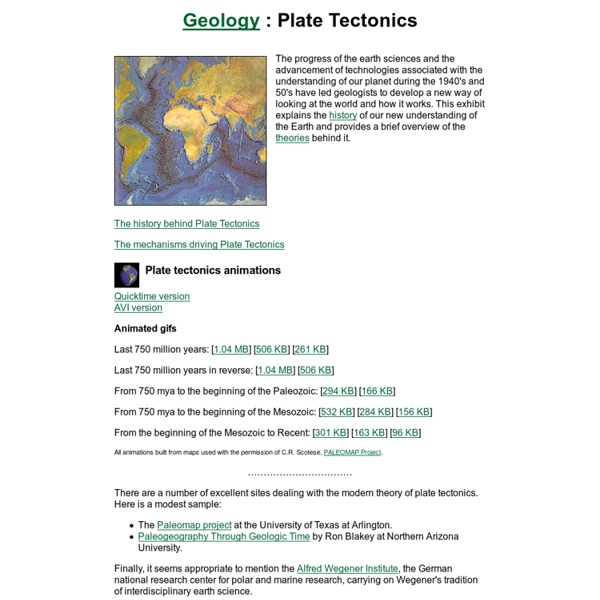Earth Floor: Plate Tectonics
The theory of plate tectonics has done for geology what Charles Darwin's theory of evolution did for biology. It provides geology with a comprehensive theory that explains "how the Earth works." The theory was formulated in the 1960s and 1970s as new information was obtained about the nature of the ocean floor, Earth's ancient magnetism, the distribution of volcanoes and earthquakes, the flow of heat from Earth's interior, and the worldwide distribution of plant and animal fossils. The theory states that Earth's outermost layer, the lithosphere, is broken into 7 large, rigid pieces called plates: the African, North American, South American, Eurasian, Australian, Antarctic, and Pacific plates. The plates are all moving in different directions and at different speeds (from 2 cm to 10 cm per year--about the speed at which your fingernails grow) in relationship to each other. With respect to plate boundaries is your home located in the middle of, or near the boundary of a plate? Next
Tectonic Plates
The edges of these plates, where they move against each other, are sites of intense geologic activity, such as earthquakes, volcanoes, and mountain building. Plate tectonics is a relatively new theory and it wasn't until the 1960's that Geologists, with the help of ocean surveys, began to understand what goes on beneath our feet. Where is the Evidence for Plate Tectonics? It is hard to imagine that these great big solid slabs of rock could wander around the globe. Scientists needed a clue as to how the continents drifted. Click here for the Scotland story Picture the following in your mind: You have a nine piece jigsaw (now there's a challenge). What do you think will happen to the puzzle? Now let's think back to our plates being created at the mid-ocean ridges, it seems to be a good idea but if this is the only type of plate movement then the world would get bigger and bigger. The floor of the Easter Pacific is moving towards South America at a rate of 9 centimetres per year.
Teachers | Technology/Engineering Classroom Activities
B-29 Frozen in Time In "Arctic Engineering," students follow problem-solving techniques used by scientists in the program and generate strategies for improving upon the scientists' solutions. Grades 6-8. Battle of the X-Planes In "Backpack Challenge," students design a backpack that meets multiple needs. Building Big: Bridges Find a collection of 10 activities -- including paper bridge, geodesic dome, and newspaper tower -- designed to introduce students to the basic physical science of large structures. Building Big: Dams Find a collection of 10 activities -- including paper bridge, geodesic dome, and newspaper tower -- designed to introduce students to the basic physical science of large structures. Building Big: Domes Find a collection of 10 activities -- including paper bridge, geodesic dome, and newspaper tower -- designed to introduce students to the basic physical science of large structures. Fireworks! Flood! Killer Quake! Roller Coaster! Saved By the Sun In "Got Sun?
International Tsunami Information Center
Welcome To Puzzles Of The Earth
As of July 1, 2013 ThinkQuest has been discontinued. We would like to thank everyone for being a part of the ThinkQuest global community: Students - For your limitless creativity and innovation, which inspires us all. Teachers - For your passion in guiding students on their quest. Partners - For your unwavering support and evangelism. Parents - For supporting the use of technology not only as an instrument of learning, but as a means of creating knowledge. We encourage everyone to continue to “Think, Create and Collaborate,” unleashing the power of technology to teach, share, and inspire. Best wishes, The Oracle Education Foundation



